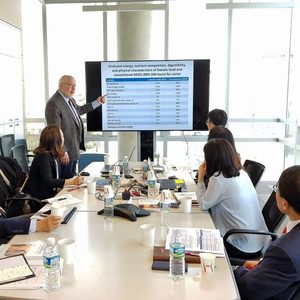USGC hosts nutritionist in South Korea to show value of US DDGS

U.S. Grains Council
May 18, 2018
BY Tim Albrecht
The U.S. Grains Council hosted Jerry Shurson, swine nutritionist with the University of Minnesota, in South Korea last month. The meeting provided expert consultation on the economic and nutritional benefits of U.S. distiller’s dried grains with solubles in animal feeds to South Korean feed formulators and nutritionists.
“The regional seminars and one-on-one company consultations were useful for providing a broad overview and creating awareness of DDGS in swine and poultry diets for diverse audiences consisting of nutritionists, researchers, traders and feed formulators,” said Haksoo Kim, USGC director in South Korea, who also participated in the consultations along with Youngjin Lee, USGC administrative manager.
In South Korea, one of the world’s largest and most competitive feed markets, DDGS are now considered an established and superior feed ingredient in the country, with 96 percent of local feed producers using it in their rations. Growth in the South Korean livestock and corn processing industries has meant the country’s demand for coarse grains and co-products has increased continuously and is expected to grow steadily in the future.
Advertisement
Advertisement
South Korea currently ranks as the second largest market for U.S. DDGS in the current marketing year (September 2017-March 2018), purchasing 639,000 tons, a 6 percent increase compared to last marketing year. South Korea was the third largest market for U.S. DDGS in 2016/2017, setting a new record for the fifth year in a row at 979,000 tons.
April’s DDGS promotion and educational activities targeted both major users and potential users in South Korea. Eighty participants attended a DDGS seminar in Seoul in addition to 20 attendees at a subsequent seminar in the Yeongnam region. Amid these larger meetings, Shurson and the Council’s staff conducted individual consultations with some of the country’s largest feed manufacturers and users of U.S. DDGS.
Shurson answered technical questions about the use of U.S. DDGS, including how to accurately determine digestible amino acid content and the maximum recommended inclusion rates in diets for each species and stage of production.
Advertisement
Advertisement
The success of efforts like these is the result of identifying leading companies in the market, learning the unique concerns and barriers to greater DDGS use, and extensive technical preparation and effective communication with existing and potential customers.
The Council will continue working to increase U.S. DDGS exports to South Korea, to reach their target of 1.2 million tons by 2022, through additional educational programs aimed at protecting existing market share, increasing the inclusion rates in animal diets and expanding business opportunities between U.S. suppliers and South Korean buyers.
“We will continue to expand the specialized and customized on-site consultation programs for feed companies to use the U.S. DDGS at the recommended levels to achieve that goal,” said Kim.
Related Stories
U.S. fuel ethanol capacity fell slightly in April, while biodiesel and renewable diesel capacity held steady, according to data released by the U.S. EIA on June 30. Feedstock consumption was down when compared to the previous month.
XCF Global Inc. on July 8 provided a production update on its flagship New Rise Reno facility, underscoring that the plant has successfully produced SAF, renewable diesel, and renewable naphtha during its initial ramp-up.
The U.S. exported 31,160.5 metric tons of biodiesel and biodiesel blends of B30 and greater in May, according to data released by the USDA Foreign Agricultural Service on July 3. Biodiesel imports were 2,226.2 metric tons for the month.
The USDA’s Risk Management Agency is implementing multiple changes to the Camelina pilot insurance program for the 2026 and succeeding crop years. The changes will expand coverage options and provide greater flexibility for producers.
EcoCeres Inc. has signed a multi-year agreement to supply British Airways with sustainable aviation fuel (SAF). The fuel will be produced from 100% waste-based biomass feedstock, such as used cooking oil (UCO).
Upcoming Events










